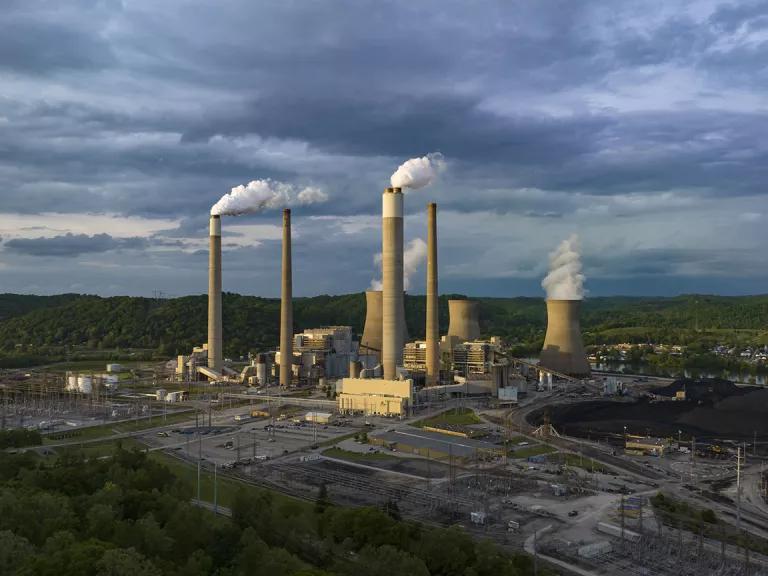Five Things to Watch for in Biden’s State of the Union Address If You Care About the Climate Crisis
This is an important moment to rally the country around the climate progress of the past three years—and show the way to build on those gains going forward.

A large-scale solar farm in the desert south of Boulder City, Nevada
Getty Images
On Thursday, President Biden will deliver the 100th in-person state-of-the-union address before a joint session of Congress, dating back to President George Washington’s 1790 address.
Never has the state of the climate been more imperiled—or the need to act more urgent. Last year was the hottest on record. Dangerous heat waves put two-thirds of the United States at risk, drought sent the Mississippi River to record lows, and wildfires burned enough land across Canada to cover the state of Oklahoma.
Small wonder why more than 7 in 10 Americans (73 percent) support federal policies to cut greenhouse gas emissions in half by 2030, as Biden has promised, and nearly two-thirds (62 percent) want Congress to do more to confront the climate crisis.
Thursday is a chance for Biden to rally the nation around the climate progress of the past three years and show the way to build on those gains going forward. Here are five things to watch for in the speech.
An unprecedented jobs boom, with clean energy at its core
Since Biden took office, the economy has added 14.8 million jobs (equivalent to the entire workforce of Australia), which is more than in any other single presidential term in history.
Unemployment has been below 4 percent for two years, the longest stretch in more than five decades. The U.S. economy grew last year at 2.5 percent—stronger than any other advanced economy in the world, the International Monetary Fund reports.
Presidents don’t control the economy. But the climate and clean energy investments that the Biden administration is implementing are an important reason for the sustained gains, in red states and blue. Together, these investments are driving the creation of nearly 100,000 jobs nationwide, including about 15,000 in Georgia, 12,000 in South Carolina, 10,000 in Michigan, and 8,800 in Texas, with additional gains in three dozen other states.
Beyond jobs and investment, the federal incentives in the Inflation Reduction Act are making electric vehicles—new and used—more affordable for low-income and medium-income drivers; helping families afford rooftop solar panels; and putting energy-saving appliances like heat pumps within reach for a growing number of businesses and homes.
The Inflation Reduction Act, though, is a 10-year program. The president should spell out how he intends to make sure the growth we’ve seen over the past two years is just the beginning, to make sure we keep strengthening the supply chain for the building blocks of a clean energy economy; cutting the nation’s carbon footprint; and reducing our reliance on the fossil fuels that pad the war chests of belligerent petro-states like Russia.

A coal-fired power plant in West Virginia
Visions of America/Joseph Sohm/Universal Images Group via Getty Images
Cutting climate pollution from the nation’s power plants
A big piece of achieving that mission is dependent on what the Biden administration is doing to limit climate-wrecking carbon pollution from power plants that burn coal and gas. As the second-largest source of carbon emissions, these dirty power plants are the source of about a third of the U.S. carbon footprint, or a quarter of the country’s overall greenhouse gas emissions.
Last spring, the Biden administration proposed new standards to curb that pollution.
The U.S. Environmental Protection Agency (EPA) affirmed last week that it would soon finalize limits on the carbon pollution from power plants that burn coal, as well as from new plants that burn natural gas. That’s a crucial step: the first carbon limits on the second-largest source of that pollution. It will result in substantial carbon reductions.
The EPA said it would delay—for now—limits on carbon emissions from existing plants that burn gas. That means the job’s not done. We can’t confront the climate crisis without slashing emissions from the existing gas-fired power plants already pumping huge amounts of carbon and other dangerous pollution into the air.
Thursday’s speech gives Biden the chance to spell out his plan to finish the job with all due dispatch.
Cleaning up cars and trucks
Burning motor gasoline and diesel fuel produces 81 percent of the carbon pollution from the transportation sector, the single-largest source of carbon emissions. Last spring, to reduce that pollution, the administration proposed the toughest limits ever on carbon emissions from the nation’s cars, pickup trucks, and heavy-duty freight trucks. Final rules are expected this spring.
The administration has hinted that the limits will be phased in over a longer period than initially proposed, to give autoworkers, the industry, and the nation’s drivers more time to embrace the shift to electric vehicles.
Even so, these new standards have the potential to cut more carbon pollution, over time, than any other single measure taken.
Again, for Biden, Thursday’s speech is the time to assure the nation that strong, durable car and truck standards are coming soon to ensure the emissions reductions required to confront the climate crisis.
Cutting the nation’s greenhouse gas emissions in half
Early in his administration, Biden pledged to cut the nation’s greenhouse gas emissions by 50 to 52 percent below 2005 levels by 2030, as the science says we must in order to avert the worst consequences of catastrophic climate change.
Taken together and done right, the climate and clean energy investments in the Inflation Reduction Act, combined with strong and effective standards for cleaning up tailpipe and power plant pollution, can speed the shift away from the fossil fuels that are driving the climate crisis and toward clean energy.
That can position the country to cut carbon pollution and other greenhouse gas emissions by up to 45 percent below 2005 levels by 2030, within striking distance of Biden’s pledge.
The country needs to hear a clear commitment from the president to finish the job.
Countering fossil fuel misinformation about LNG
Biden should also make the case for his decision in January to hit pause on the review of new terminals to export liquefied natural gas (LNG) far into the future. The fossil fuel industry and its congressional allies have spread disinformation about this pause.
The president made the right call. It’s time to set the record straight.
Critics have falsely claimed the pause will impact the country’s near-term LNG exports. It won’t. U.S. LNG exports have grown 39 percent on Biden’s watch, making this country the largest LNG exporter in the world. Those exports will grow again this year, next year, and the year after that, nearly doubling by 2027, due to new LNG export terminals that have already been approved and are under construction.
Biden’s pause will have zero impact on that growth.
It will have no impact, either, on U.S. LNG exports to Europe, which buys nearly 70 percent of U.S. LNG. In the months after Russia invaded Ukraine, U.S. LNG exports to Europe more than doubled, making the United States the largest supplier of LNG to Europe and a key to European efforts to sever ties with Russian gas.
None of that is affected by Biden’s commonsense pause.
It only applies to prospective new terminals, which take between four and six years to build. We’re talking about exports that won’t even begin until 2028—at the soonest.
The 27 member states of the European Union have pledged to stop buying Russian gas by then. Global demand for gas, for that matter, will be well on its way toward peaking, say private analysts and the International Energy Agency, before beginning a steady decline, as countries pursue their climate goals.
It’s only prudent that the administration take stock of these shifts and the urgent need to address the climate crisis as it determines whether the public interest is served by locking our children and grandchildren into decades’ more dependence on fossil fuels.




